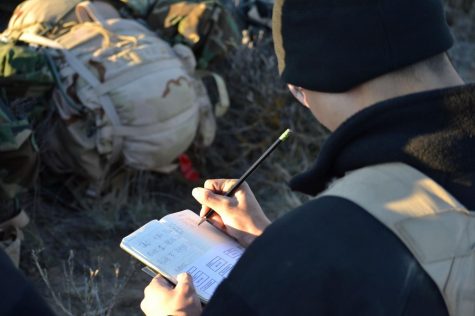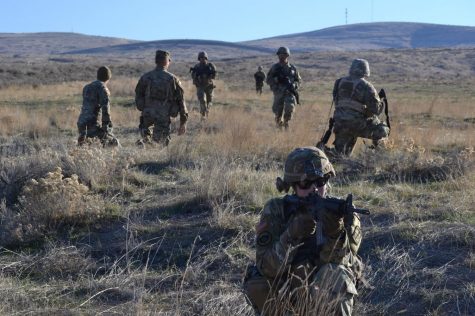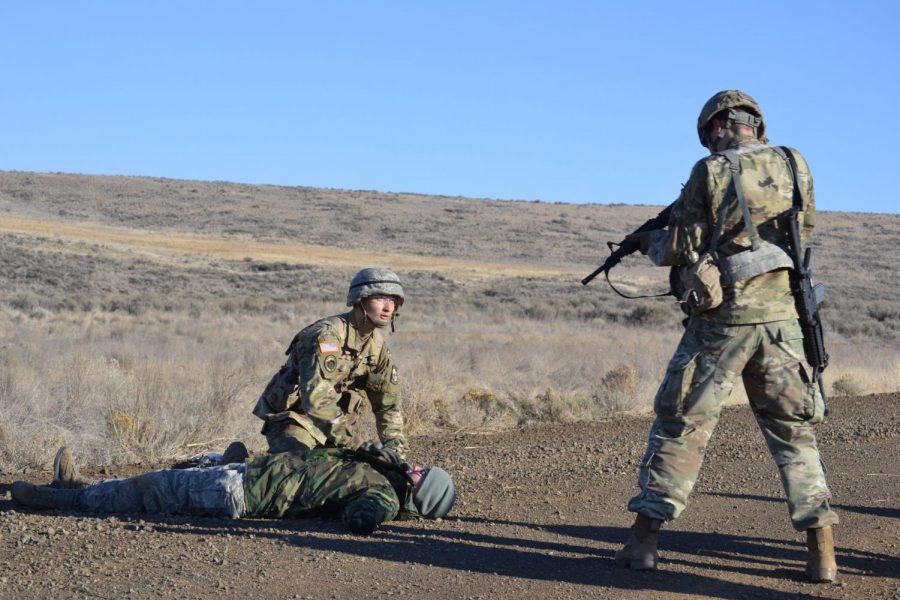ROTC finishes fall quarter with training in Yakima
November 30, 2018
CWU ROTC travels to the Yakima Training Center so that cadets can practice combat skills twice a year, with one trip in the fall and the other in the spring.
The purpose of this training is for new cadets to learn the basics of infantry-style combat, while senior cadets practice leadership and officer skills.
According to Major Bonnie Kovatch, the entire training weekend is run by ROTC seniors. The seniors had to plan everything from what training courses were taught to where the porta-johns were located. The work is split up between about 15 seniors, each with a job assigned to them based on past performance and what they need to improve.
For example, if someone scored well in teamwork, but needed to improve their planning and coordination skills, they would be assigned to organize transportation, a job that requires teamwork as well as scheduling.

The training lasted three days, from Friday Nov. 16 to Sunday Nov. 18. Friday was mostly classroom teaching, which involved basic rifle and machine gun training, grenade training, first aid and land navigation (Land Nav).
This training was then implemented on Saturday, when the cadets were tasked with finding points during Land Nav and then running four lanes of combat scenarios. Sunday was mostly clean-up, but there were also squad awards in the morning.
Land Nav started at 8 a.m. Saturday morning, and required that cadets find four markers by hiking through the Yakima hills. Using only basic, non-electronic tools, first and second-year students would be working in teams of two, while third years had to find points by themselves.
Fourth-year cadet Bradley Lewis was in charge of setting up the Land Nav course. He explained that each point was a marked with a flag and had a postcard with a number on it. The cadets wrote down this number to prove that they found the correct points. There were a close to a total of 30 points, and cadets had to find the four that were assigned to them.
Lewis said that when creating the course, they tried to get it as close as possible to the advanced course that all ROTC juniors complete over the summer in Fort Knox, Kentucky.
“To do Land Nav, you need common sense and the ability to terrain associate,” Cooper said. “When you plot your points, if you don’t route plan accordingly, you might end up like we did, seeing a cliff and looking on the map… When using common sense, you just need to think, ‘where would they put it [the marker]?’”
After Land Nav, Cooper and Randall met up with their squad for lunch, which consisted of the standard field food known as MREs (Meal Ready to Eat). After lunch, First Squad, which consisted of Edgar Hernandez, Enrique Barreto, Derek Parala, Maggie Hall, Christopher Nelson, Kobe Merriweather as well as Cooper and Randall, moved over to Lanes. Lanes was the name given to the four practice battle situations that the squad would need to complete together. The squad was instructed by senior Jacob Lamay, who had been a part of First Squad before he took charge of it when he became a senior.

Cadets carry the wounded after a simulated ambush.
According to Lamay, most of this squad has been together for at least a couple of years. Ideally, ROTC likes to keep the squad together as much as possible, and if you are new to a squad, it is likely that you are new to ROTC.
“What we are doing today is tactical STX lanes,” Lamay said. “Each squad is going to be given a tactical problem to solve… you are going to have four different stations, each one is going to have a different leader and a different situation.”
The squad’s first task was to ambush an enemy unit, which was played by ROTC Air Force. This mission involved the squad hiking around hills and then getting into a position that concealed them, while allowing them a clear line of sight to the enemy. On the order, the squad opened fire. However, because there were no blank rounds available, the sound of people yelling “BANG” substituted for gunshots.
Enrique Barreto was the squad leader for the ambush scenario. This was his first time leading a situation.
“It’s good because they give you the situation but then they throw a lot of stuff at you while you are going, so it keeps you on your toes,” Barreto said. “We make all these plans, but we also got to realize that it’s gonna hit the fan one way or another, so you gotta be ready to make a new plan at any time.”
The second lane was grenade training. This situation was much more organized and involved the cadets taking turns throwing a metal ball formed to roughly mimic the size and shape of a hand grenade at various targets.
“The grenades (training) was very good,” Barreto said. “Everyone got a chance to put what we had learned on Friday into action, so I thought that was very cool.”
The third lane had the squad moving towards an enemy location, only to find out that the enemy was much closer than they were told. This way, the instructors would be able to see how the squad would react to a surprising situation.
“There’s a lotta new guys out here including myself to this ROTC program,” Merriweather said. “It’s still a learning experience, and I think that everyone is still learning.”

The fourth and final lane exercise was a surprise to all the cadets in the squad. Lamay told them that it was a simple mission to refill ammo and water, when secretly, opposing forces were setting up an ambush.
After a five minute walk, the squad found itself under intense fire from a distant hill, and Lamay announced that one of the cadets had been killed, and another had been wounded. This meant that First Squad had to fend off an ambush while tending to their wounded. The cadets split up, some providing cover fire while others applied a tourniquet to the “wounded” and carried the “deceased” away from the battle. However, Lamay had another surprise for the squad. After about a minute of holding their position, Lamay screamed out “incoming artillery!” and then made a noise similar to a bombing dropping. The cadets figured it out quickly and started running away from the position that they had been holding.
This completed the exercise, but it didn’t complete the training. Next on the planner was night navigation, and then an early wake up the next morning. One cadet described the weekend as a fun couple of days, but people don’t get much sleep. ROTC packed their things and left the training cent oner Sunday. The next training session will be in the spring, which has been described as a much more advanced and intense weekend.



